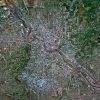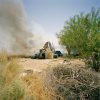Statement:
When photographer Dorothea Lange and author John Steinbeck created their works on transient populations during the Great Depression, the Recreation Vehicle (RV) industry was already in its infancy. After World War II, American industrial might was redirected from tending to the war effort to meeting pent-up consumer demand and the needs of returning service men and women. Increased employment to meet these demands provided a dramatic boost in the American standard of living. One result was the expansion of a mobile lifestyle in the American middle class. Trailers and self-contained RVs became the means and the mode of transportation to live elsewhere and to experience the country without sacrificing the comforts of home.
Although designed as a temporary travel home and in contrast to its use by affluent Snowbirds, the RV has also become primary residence for many people of limited means. They make homes for themselves in RV parks, on the public lands maintained by the Bureau of Land Management (BLM), or by “squatting” off the grid in the desert Southwest. Many individuals find RVs a better choice than apartments or hotels since there is ownership of the abode, with the occasional trade off of needing to pay for the rental of the land.
In this project, I have been photographing and interviewing individuals with a transitory lifestyle along with creating landscape images of the areas they occupy.














